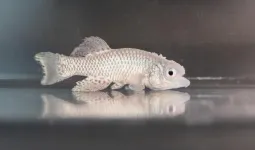(Press-News.org) Nearly one in five school-aged children and preteens now take melatonin for sleep, and some parents routinely give the hormone to preschoolers, according to new research from the University of Colorado Boulder published Nov. 13 in JAMA Pediatrics.
This concerns the authors, who note that safety and efficacy data surrounding the products are slim, such dietary supplements lack full regulation by the Food and Drug Administration.
“We hope this paper raises awareness for parents and clinicians, and sounds the alarm for the scientific community,” said lead author Lauren Hartstein, PhD, a postdoctoral fellow in the Sleep and Development Lab at CU Boulder. “We are not saying that melatonin is necessarily harmful to children. But much more research needs to be done before we can state with confidence that it is safe for kids to be taking long-term.”
Calls to poison control centers up
Melatonin is produced naturally in the pineal gland to signal the body that it is time to sleep and regulate its circadian rhythm—the physiological cycle over a 24-hour period.
In many countries, the hormone is classified as a drug and available by prescription only.
In the United States, however, chemically synthesized or animal-derived melatonin is available over the counter as a dietary supplement, and increasingly available in child-friendly gummies.
“All of a sudden, in 2022, we started noticing a lot of parents telling us that their healthy child was regularly taking melatonin,” said Hartstein, who studies how environmental cues, including light at night, impact children’s sleep quality and melatonin production.
During 2017-18, only about 1.3% of U.S. parents reported that their children used melatonin.
To get a sense of the current prevalence of use, Hartstein and colleagues surveyed about 1,000 parents in the first half of 2023.
Among children ages 5 to 9, 18.5% surveyed had been given melatonin in the previous 30 days. For preteens ages 10 to 13, that number rose to 19.4%. Nearly 6% of preschoolers ages 1 to 4 had used melatonin in the previous month.
Preschoolers who used melatonin had been taking it for a median length of a year. Grade-schoolers and preteens had used it for median lengths of 18 and 21 months, respectively.
The older the child, the greater the dosage, with preschoolers taking anywhere from 0.25 to 2 mg and preteens taking up to 10 mg.
A need for caution
In a study published in April, researchers analyzed 25 melatonin gummy products and found that 22 contained different amounts of melatonin than the label indicated. One had more than three times the amount on the label. One had none at all. In addition, some melatonin supplements have been found to contain other concerning substances, such as serotonin.
“Parents may not actually know what they are giving to their children when administering these supplements,” said Hartstein.
Some scientists have also raised concerns that giving melatonin to young people whose brains and bodies are still developing could influence the timing of puberty onset.
The few small-scale human studies that have looked into this have yielded inconsistent results.
Gummies, specifically, also carry another risk: They look like and taste like candy.
From 2012 to 2021, the authors note, reports of melatonin ingestion to poison control centers increased 530%, largely occurring among children under age 5. More than 94% were unintentional and 85% were asymptomatic.
A place for judicious use
Co-author Julie Boergers, PhD, a psychologist and pediatric sleep specialist at Rhode Island Hospital and the Alpert Medical School of Brown University, said that when used under the supervision of a health care provider, melatonin can be a useful short-term aid, particularly in youth with autism or severe sleep problems.
“But it is almost never a first-line treatment,” she said, noting that she often recommends that families look to behavioral changes first and use melatonin only temporarily. “Although it’s typically well-tolerated, whenever we’re using any kind of medication or supplement in a young, developing body we want to exercise caution.”
Anecdotally, she has heard from parents that the supplement often works well in the beginning but over time children may need higher doses to achieve the same effect.
Introducing melatonin early in life could also have another unintended consequence, said Hartstein: It could send a message that, if you have trouble sleeping, a pill is the answer.
The authors caution that the study was relatively small and does not necessarily represent usage nationwide. It is telling nonetheless.
“If this many kids are taking melatonin, that suggests there are a lot of underlying sleep issues out there that need to be addressed,” Hartstein said. “Addressing the symptom doesn’t necessarily address the cause.”
END
Study finds melatonin use soaring among youth
2023-11-13
ELSE PRESS RELEASES FROM THIS DATE:
How good can overpower evil in the genetic determination of Alzheimer’s disease
2023-11-13
San Francisco—November 13, 2023—Researchers at Gladstone Institutes have discovered that a rare genetic variant known as the “Christchurch mutation” can block detrimental effects of apolipoprotein E4, the best-established risk factor for the most common form of Alzheimer’s disease.
The apolipoprotein E (APOE) gene has long been known to affect the risk of Alzheimer’s disease through its three main variants: E2 (low risk), E3 (intermediate risk), and E4 (high risk). More recently, a ...
Recreation of ancient seawater reveals which nutrients shaped the evolution of early life
2023-11-13
Scientists know very little about conditions in the ocean when life first evolved, but new research published in Nature Geoscience has revealed how geological processes controlled which nutrients were available to fuel their development.
All life uses nutrients such as zinc and copper to form proteins. The oldest lifeforms evolved in the Archean Eon, three and a half billion years before the dinosaurs first appeared. These microbes showed a preference for metals such as molybdenum and manganese compared to their more recent counterparts. This ...
Cycle of fasting and feeding is crucial for healthy ageing
2023-11-13
Fasting interventions, which involve alternating periods of fasting and refeeding, are generally thought to improve health. But these interventions don’t work as well in old animals. The question is: Why? By studying the short-lived killifish, researchers at the Max Planck Institute for Biology of Ageing in Cologne have shown that older fish deviate from a youthful fasting and refeeding cycle, and instead enter a state of perpetual fasting, even when ingesting food. However, the benefits of refeeding after fasting in old killifish can be restored by genetically activating a specific subunit of AMP kinase, an important sensor ...
How climate change could be affecting your brain
2023-11-13
A new element of the catastrophic impacts of climate change is emerging – how global warming is impacting the human brain.
In a paper published today in Nature Climate Change, an international team of academics explore the ways in which research has shown that a changing environment affects how our brains work, and how climate change could impact our brain function in the future. The paper is led by the University of Vienna with input from the universities of Geneva, New York, Chicago, Washington, Stanford, Exeter in the UK and the Max Plank Institute in Berlin. It also explores the role that neuroscientists can play in further understanding and addressing ...
Reducing systolic blood pressure to less than 120 mm Hg reduced cardiovascular event risk
2023-11-13
Research Highlights:
In a 3-year trial, intensive treatment with antihypertensive medication to reduce systolic blood pressure, the top number, to less than 120 mm Hg reduced cardiovascular disease events among people at high-risk for cardiovascular disease by 12% compared to standard treatment with a target of less than 140 mm Hg.
The effects were consistent regardless of participants’ diabetes status (Type 1, Type 2 or none) or history of stroke.
Embargoed until 8 a.m. ET, Monday, Nov. 13, 2023
PHILADELPHIA, ...
Ovarian cancer: Artificial intelligence predicts therapy responses
2023-11-13
A model based on artificial intelligence is able to predict the therapy outcome (measured by volumetric reduction of tumor lesions) in 80% of ovarian cancer patients. The AI-based model has an accuracy of 80%, significantly better than current clinical methods. The tool, named IRON (Integrated Radiogenomics for Ovarian Neoadjuvant therapy), analyzes various patient clinical features, from circulating tumor DNA in the blood (liquid biopsy) to general characteristics (age, health status, etc.), tumor markers, and disease images obtained through CT scans. ...
American Heart Association honors Gladstone President Deepak Srivastava with Distinguished Scientist Award
2023-11-13
Deepak Srivastava, MD, president of Gladstone Institutes and a renowned cardiovascular researcher, took the stage on Saturday in Philadelphia to receive the American Heart Association’s Distinguished Scientist award—joining a preeminent group of scientists and clinicians who’ve earned the association’s highest honor over the past decade.
The American Heart Association applauded Srivastava for his significant, original, and sustained scientific contributions that have advanced the association’s mission: “To be a relentless ...
Second-most distant galaxy discovered using James Webb Space Telescope
2023-11-13
The second- and fourth-most distant galaxies ever observed have been discovered in a region of space known as Pandora’s Cluster, or Abell 2744, using data from NASA’s James Webb Space Telescope (JWST). Following up on a deep field image of the area, an international team led by Penn State researchers confirmed the distance of these ancient galaxies and inferred their properties using new spectroscopic data — information about light emitted across the electromagnetic spectrum — from JWST. At nearly 33 billion light years away, these incredibly distant ...
Researchers explore origins of lupus, find reason for condition’s prevalence among women
2023-11-13
For years, researchers and clinicians have known that lupus, an autoimmune condition, occurs in women at a rate nine times higher than in men. Some of the factors that cause the disease’s high prevalence in women have eluded discovery, but in a new study investigating the immune system processes in lupus and the X chromosome, Johns Hopkins Medicine researchers have uncovered answers about the disease’s frequency in females.
A number of dysregulated genetic and biological pathways contribute to the development of lupus and its varied symptoms of muscle and joint pain, ...
Capture or reuse CO2 as a chemical source for the production of sustainable plastics
2023-11-13
A scientific team has developed a new polyurethane production technique using CO2 to create new types of easily recyclable plastics. The study, published in the Journal of the American Chemistry Society (J.A.C.S.), could provide a solution for the development of truly sustainable plastics.
Commodity plastics have transformed global industry. Whether in construction, clothing, vehicles or food packaging, these plastics are everywhere in our daily lives, so much so that their global use has been estimated at around 460 million tons in 2019. This number is staggering, but not surprising, because plastics, also known as synthetic polymers, have met a large ...




